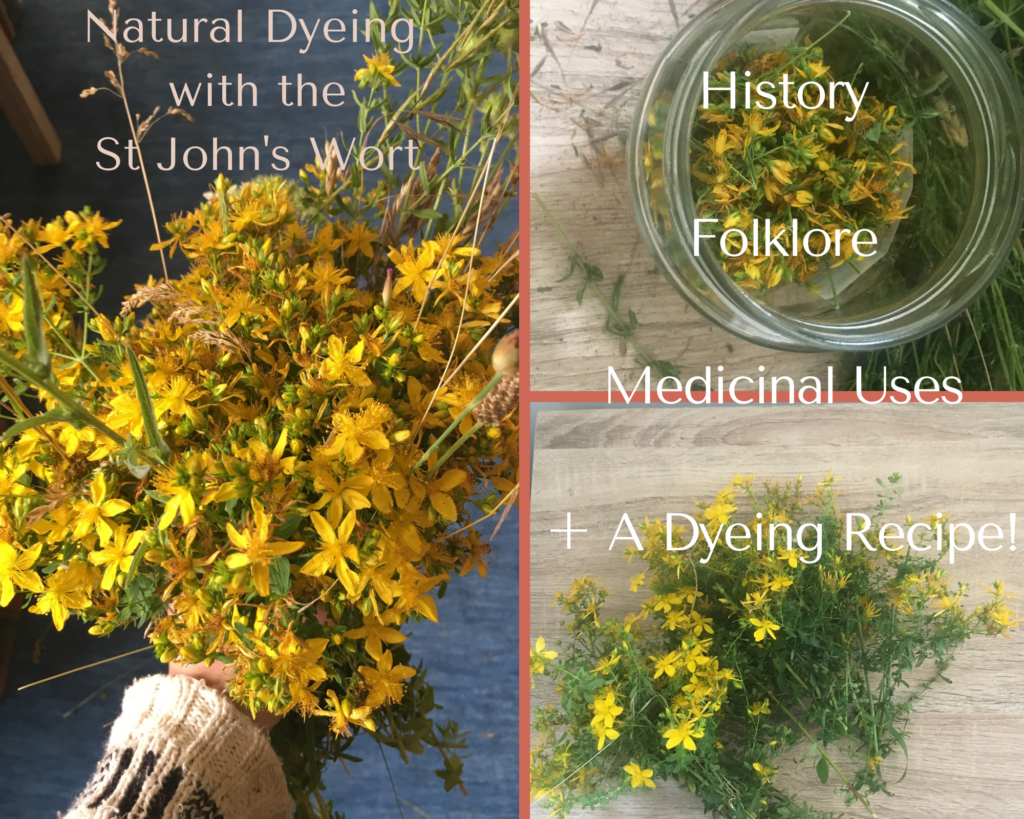
Today, the spotlight is on the St John’s Wort. This flower has been known for its medical properties for thousand of years and is rich in symbolism around the summer solstice.
So, let’s talk about the history, folklore, medicinal uses and of course the different methods for natural dyeing of the St John’s Wort.
Before diving into the different methods for natural dyeing, let’s start with its history and folklore
The uses of St John’s Wort through history
Let’s start with some botanical facts
We know from the Encyclopaedia Britannica that the St John’s Wort, also known as Hypericum, gathers actually 500 species under its name. What we call St John’s Wort when referring to the plant known for its medicinal and dyeing properties, is the Hypericum Perforatum.
We love the flowers for its bright and perforated petals and how easily you can find them growing by the side of the road in Western European countries but it’s actually classified as an invasive species in South Australia, South Africa, South America and North America. It’s called Millepertuis, a thousand holes, in French because of the holes you can see in the petals when you held it up to the sun. It’s a great way to make sure you’re holding Hypericum Perforatum.
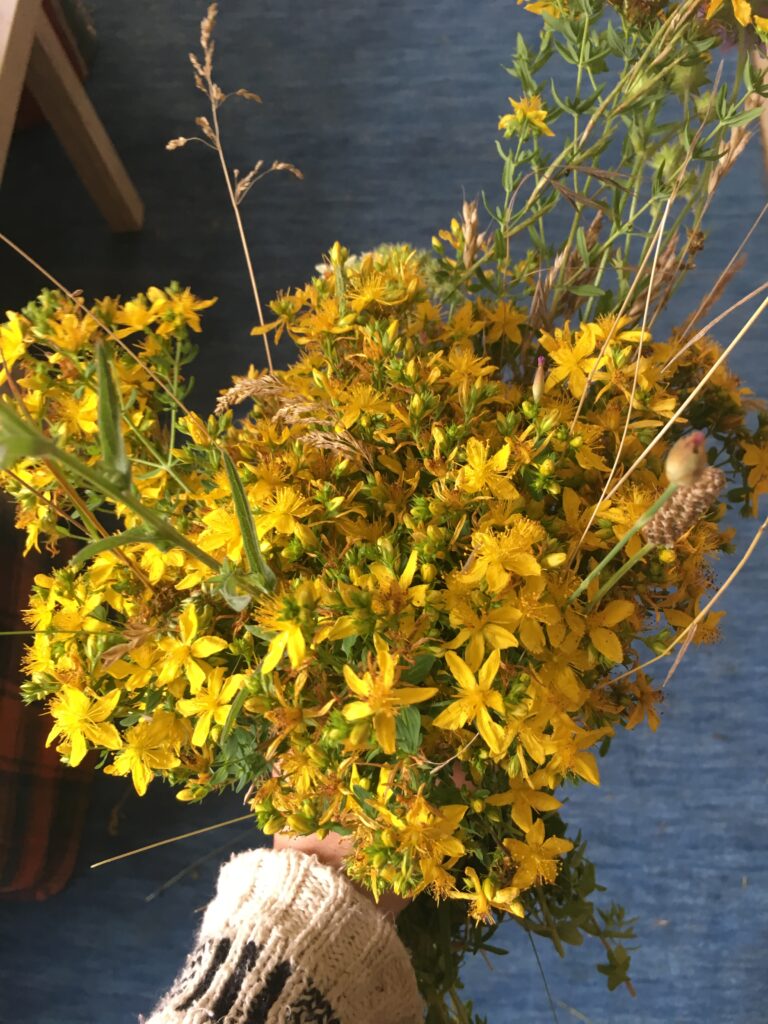
And what about St John’s Wort through history?
We find mentions of the St John Wort in the Antiquity where famous Greek physicians like Dioscorides, Pliny and Hyppocrates recommended its use to treat wounds, snake bites, burns but also menstrual disorders.
It’s no surprise then that Hypericum Perforatum was among the plants forming the Theriak, the panacea that the Emperor Nero took to protect himself from poison.
Christianisation-doing some cultural appropriation as usual-dedicated Hypericum Perforatum and the time of the summer solstice to St John the Baptist, the red pigment of the flower akin to his blood (remember his beheading and then Salomé having to deal with his head on a silver platter because women have to do all the work, all the time!)
St Columbia, the one establishing monasteries left and right in Ireland, was said to carry St John’s Wort on him, as spiritual protection and in honor of St John’s the Baptist but since monks were well versed into healing practices, we can assume it was also for medicinal purposes.
Then later on, the plant travelled with the settlers in North America, where the plant started to spread as well.
So much folklore involving the St John's Wort!
Of course, history and folklore are always interwoven and the St John’s Wort is especially rich in folk tales.
The earliest mentions of the Hypericum, as I explained earlier, were from Greek and Roman sources. Its Greek name is made from Hyper, “over” and Eikon, “apparition”. From that time on, the plant was thought of as a talisman against evil spirits, one of its names being Fuga Daemonum.
Who says demons says Middle Ages and they don’t disappoint. The plant was used to protect houses and its inhabitants by hanging it over the doors, blocking all access to evil spirits and witches. The ones who believed they had been possessed would inhale concoctions of the plant.
Peak blooming for the plant (when the active properties are the highest) is around the 24th of June, which is also the day after the celebration of St John’s the Baptist. People would put talismans under their pillows in the hope the saint would visit them and protect them from death for one more year. As often, Christian traditions come from older, pagan rituals where it was a time for offering to deities of the sun but also fertility and harvest. One of the meanings behind the name Hypericon is actually linked to Helios, the sun whose father was the titan Hyperion.
Picking the Hypericum Perforatum during the night of the summer solstice was said to be the best time if one wanted to be sure to activate its magical properties: warding off demons and ghosts.
Crusaders and knights would also use it as a talisman against witchcraft, doubling as a handy herbal treatment against their wounds.
And of course, St John’s Wort was also used for natural dyeing since the yellow it yields is the easiest colour to get from this plant but more on that later.
St John’s Wort: A plant famous for its medicinal uses
Well-known properties against depression
As we have seen it, St John’s Wort was recognised as a healing plant since the Antiquity where it was noticed that it had a calming effect.
This is must have also been one of the reasons why the plant was prescribed to those suffering of melancholy. From that time, the Hypericum Perforatum was used for depression and is still a known herbal alternative. It helps against anxiety, mild depression and sleep deprivation.
It’s actually poisonous to livestock because of the photosensitivity it can induce when the animals eat the black glands under the petals of the flowers.
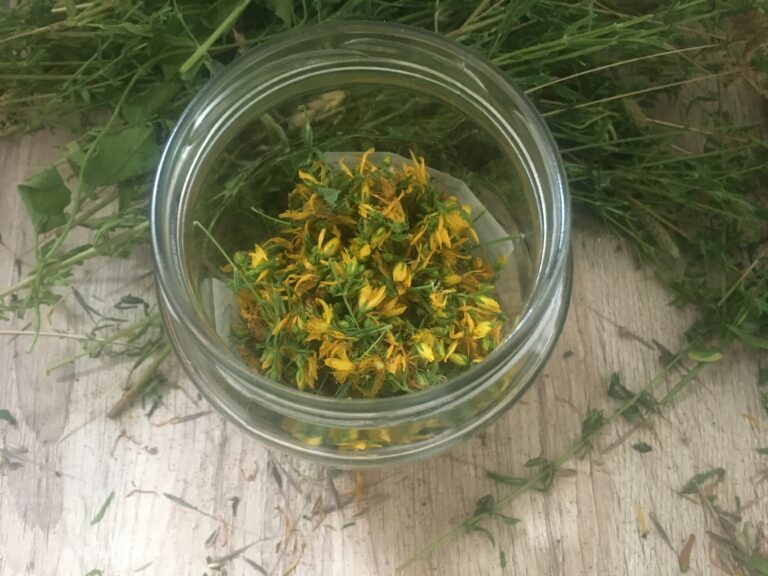
Common uses of the Hypericum Perforatum
A very efficient oil
Gathering St John’s Wort’s flowers and putting them for a month in a jar full of oil will give you a great oil to treat sunburn and skin irritation. The oil will turn red thanks to the hypericin released by the flowers. If you want to make your own oil this summer, you can follow the steps from this St John’s Wort’s oil recipe’s video on Youtube (it’s 30 minutes long so full of details) but be careful of the sun after applying it since it’s photosensitive.
It’s a herbal tea too!
You can also drink the St John’s Wort by boiling water with one tablespoon of leaves for two minutes then let it infuse for ten minutes before drinking it. If you want more details about making your own St John’s tea, I found a more detailed recipe with benefits and side effects.
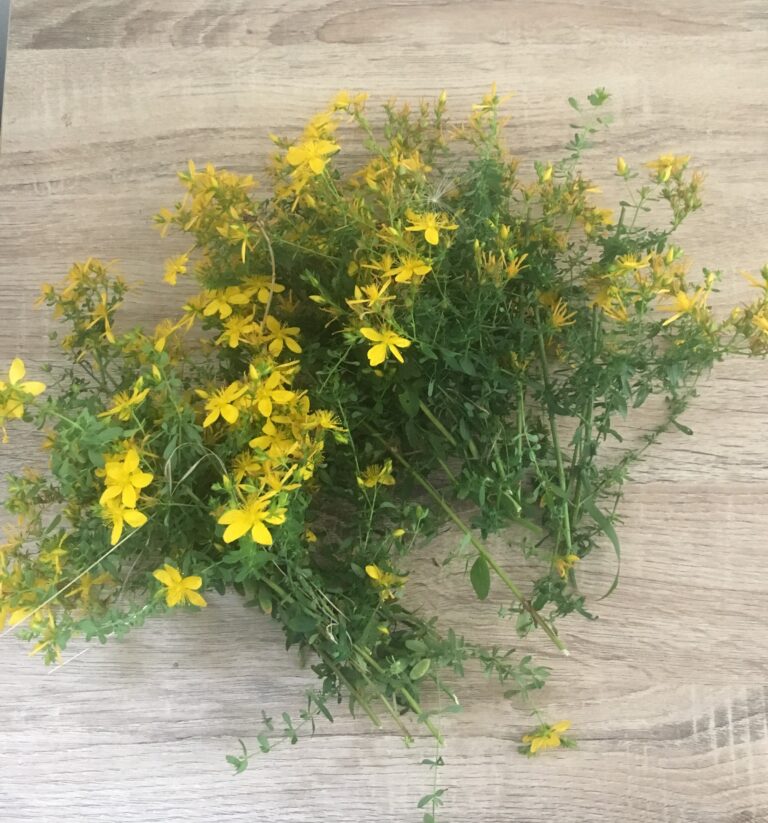
How to use the St John’s Wort for natural dyeing
The different colourways you can get with St John’s Wort
St John’s Wort has a lot of great properties but is also known for natural dyeing. It belongs to the flavonoids group, the most common group of chemical dyes (if you want to know more about the dyes group, we talk about natural dyes and chemistries in this article we wrote last year)
St John’s Wort is really fun for natural dyeing because you can actually get three different colorways, depending on how you use the dye. Jenny Dean’s Wild Colours, one of her most known publications walks you through the different step to obtain yellow then green then red.
My recipe for natural dyeing with St John’s Wort
I choose to focus on the easiest colorway you get with St John’s Wort, yellow. I don’t obtain the same results from one to the other depending on the weather. The first time I used St John’s Wort for natural dyeing, I got a vivid yellow, reminiscent of the hot summer days when I picked the flowers. The following year, we had an especially violent frost that killed a lot of crops, trees and vineyard and it must have impacted the dyed plants since the yellow I obtained was really pale.
For realising a project with St John’s Wort, you will need:
Roughly 100g of St John’s Wort’s flowers . The idea is to get the same weight for the dyestuff and the items to dye. The hypericin, the red pigment where the medicinal properties and the dye are, is located in the black holes over the petals and under the leaves. You can get different results with mordanted and unmordanted fibers but here, I decided to mordant it.
A pot large enough for water, St John’s Wort and your wool. Keep this pot for dyeing purposes only, especially if you choose to mordant your fibers and don’t use your dyeing material for cooking.
A sieve but it’s really optional with leaves. I prefer to cover my fibres with the leaves and just have wrap around the fibres as much as possible.
Process for dyeing with St John’s Wort
Remove your fibers from their mordanted bath, gently remove the excess of water (if you don’t know how to mordant, follow the steps on our post about easy recipes to become a natural dyer.)
Fill a big pot with water then add your St John’s Wort.
Heat up the water but don’t let it reach the boiling point.
Let the pot of water and St John’s Wort simmer for 1 hour.
Turn the heat off and let it cool down a bit. It’ll give you richer and deeper colors if you leave it the whole night or at least several hours before straining your dye bath.
Now, it’s time to strain your dye bath. Use your sieve or your hands (with gloves) to strain your plum tree leaves.
Remove your fibers from their mordanted bath, gently remove the excess of water and let them soak all the color up by immersing them in the dye bath.
Heat up the pot slowly again so it can simmer for about 1 hour.
Let it cool down.
Once again it’s better to leaver your fibers several hours or a whole night in the dye bath. This way, the color will only get deeper.
Once it has cool down, rinse the fibers in cold water, let it dry and brag about your hard work!
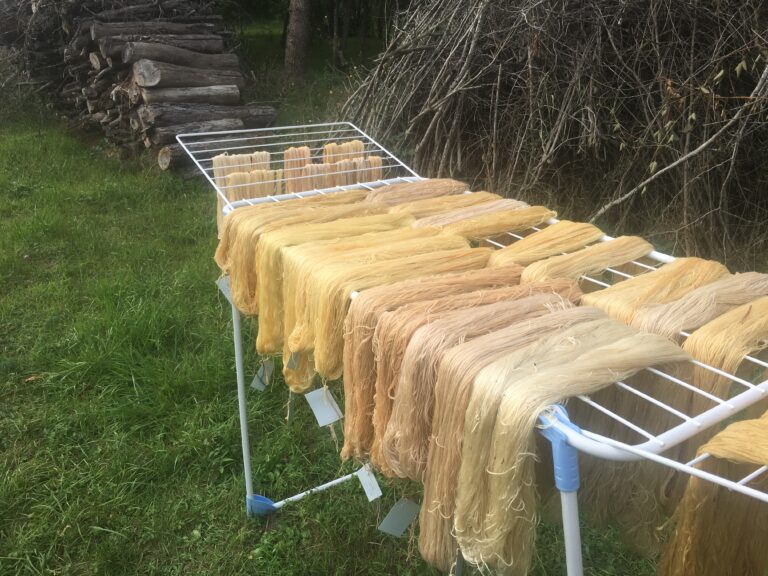
St John’s Wort is also known as the witch’s herb and you can probably see why now. This pretty flower is rich with history, medicinal properties without forgetting about the range of colours you can get from natural dyeing with St John’s Wort.
It’s also the summer plant we chose for our fourth natural dyeing embroidery kit in our Seasonal Embroidery Collection!
In it, you will find a special embroidery kit with a summer illustration, a mini-Zine created only for this kit, a skein of vegan thread dyed with St John’s Wort leaves and of course, a pattern representing the different parts of the Hypericum Perforatum. It’s completely beginner friendly and perfect to celebrate the summer solstice!
If you enjoyed reading about this plant and liked the natural dyeing recipe, then take a look at the other natural dyeing recipes in our Seasonal Embroidery Collection: You can start dyeing with the walnut tree in autumn or try your hand at natural dyeing with pomegranate in winter or natural dyeing in spring with the plum tree!

Do you have links to the science behind this?
The macerated oil, done properly loses the photosensitive properties associated with the flower. Obviously it is an oil so would not be recommended on skin in sunlight but no wise than any other oil based treatment.
Cheers